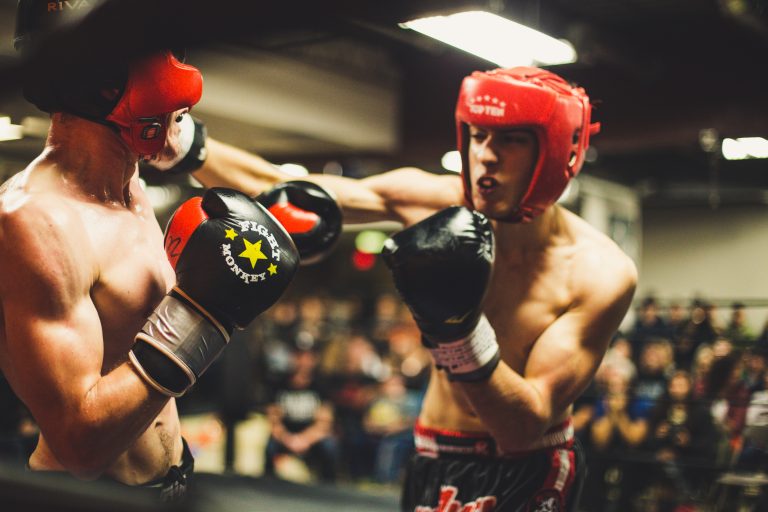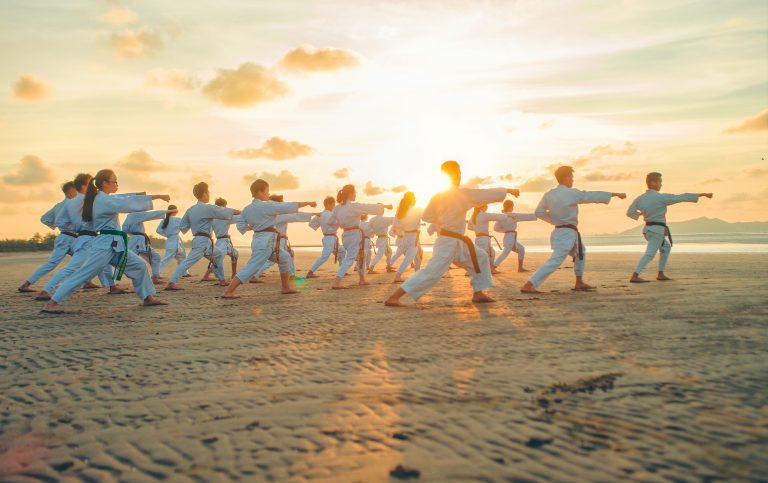Shotokan Karate Gürtelanforderungen
Shotokan Karate ist eine der bekanntesten und am meisten praktizierten Karate-Disziplinen der Welt. Es ist eine Kunst, die sowohl körperliche als auch geistige Stärke fördert. Es gibt verschiedene Grade in Shotokan Karate, von Anfängern bis hin zu Meistern. Die Karate-Gürtelfarbe repräsentiert den Fortschritt eines Karateschülers in dieser Kampfkunst. In diesem Blogbeitrag werden die Anforderungen für die verschiedenen Karate-Bandstufen im Shotokan Karate erläutert.
Weiße Gürtel (9. Kyu)
Ein weißer Gürtel bedeutet, dass der Karate-Schüler ein Anfänger ist und keine Vorerfahrung in Shotokan Karate hat. In dieser Phase lernt der Schüler grundlegende Bewegungen wie Faustschläge und Tritte. Er oder sie muss auch die Grundlagen der Karate-Etikette, der Haltung und der Atmung verstehen.
Gelbe Gürtel (8. Kyu)
Ein gelber Gürtel bedeutet, dass der Karate-Schüler grundlegende Schläge und Tritte beherrscht und in der Lage ist, einfache Kombinationen auszuführen. Der Schüler sollte auch die Grundlagen der Kata (eine Abfolge von Techniken) kennen.
Orange Gürtel (7. Kyu)
Ein orangefarbener Gürtel bedeutet, dass der Karate-Schüler seine Techniken verbessert hat und jetzt in der Lage ist, schnellere und stärkere Schläge und Tritte auszuführen. Der Schüler muss auch in der Lage sein, fortgeschrittenere Kombinationen und Kata auszuführen.
Grüne Gürtel (6. Kyu) und Blaue Gürtel (5. Kyu)
Die grüne und blaue Gürtel bedeuten, dass der Karate-Schüler ein fortgeschrittenes Niveau erreicht hat und in der Lage ist, komplexere Kombinationen und Kata auszuführen. Der Schüler muss auch in der Lage sein, seine Techniken mit größerer Genauigkeit und Geschwindigkeit auszuführen.
Braune Gürtel (4. Kyu – 1. Kyu)
Die braunen Gürtel sind für fortgeschrittene Schüler reserviert, die ihr Wissen und ihre Fähigkeiten im Shotokan Karate erweitert haben. In dieser Phase müssen die Schüler eine Reihe von fortgeschrittenen Kombinationen und Kata beherrschen. Die Anforderungen an die braunen Gürtel können je nach Schule unterschiedlich sein, aber alle Schüler müssen die Techniken mit hoher Genauigkeit und Geschwindigkeit ausführen können.
Schwarzer Gürtel (1. Dan und höher)
Ein schwarzer Gürtel wird nur an fortgeschrittene Karate-Schüler vergeben, die eine jahrelange Erfahrung im Shotokan Karate gesammelt haben. Die Anforderungen und Standards für den schwarzen Gürtel können von Schule zu Schule unterschiedlich sein, aber alle Schüler müssen alle Techniken und Kombinationen perfektioniert haben, um eine hohe Genauigkeit und Geschwindigkeit zu erreichen.
Insgesamt ist Shotokan Karate eine Kampfkunst, die Geduld, Durchhaltevermögen und harte Arbeit erfordert. Die Karate-Gürtel sind ein Symbol für die Fortschritte und Leistungen eines Schülers im Shotokan Karate. Durch das Verstehen der Anforderungen und der Bedeutung der verschiedenen Gürtel erhalten Karate-Schüler eine klare Vorstellung davon, was von ihnen erwartet wird, um den nächsten Karate-Gürtel zu erreichen.
Frequently Asked Questions About Shotokan Karate Gürtelanforderungen
If you are a beginner in Shotokan Karate, you may be wondering what it takes to earn a new belt rank. Each belt in Shotokan Karate has requirements that must be met before a student can advance to the next level. In this blog post, we will answer some of the most frequently asked questions about Shotokan Karate Gürtelanforderungen.
What are Gürtelanforderungen?
Gürtelanforderungen is a German term that means belt requirements. The Shotokan Karate belt system is divided into different colors, and each color represents a level of proficiency. To advance to the next belt rank, a student must demonstrate proficiency in a set of skills and techniques.
What are the different belt colors in Shotokan Karate?
The belt colors in Shotokan Karate are white, yellow, orange, green, blue, brown, and black. The white belt represents a beginner, and the black belt represents mastery of the style. The colors in between represent different levels of proficiency.
What are the requirements for each belt rank in Shotokan Karate?
The requirements for each belt rank in Shotokan Karate vary, but they generally include:
White Belt
- Learning the basic stances, punches, and kicks
- Learning the etiquette and basic rules of the dojo
- Demonstrating proper breathing techniques and focus
Yellow Belt
- Demonstrating proficiency in the basic techniques learned at the white belt level
- Learning additional techniques such as blocks and combinations
- Participating in sparring and basic self-defense drills
Orange Belt
- Demonstrating proficiency in the techniques learned at the white and yellow belt level
- Learning additional techniques such as throws and sweeps
- Participating in more advanced sparring and self-defense drills
Green Belt
- Demonstrating proficiency in the techniques learned at the white, yellow, and orange belt level
- Learning more advanced techniques such as joint locks and advanced throws
- Participating in more advanced sparring and self-defense drills
Blue Belt
- Demonstrating proficiency in the techniques learned at the white, yellow, orange, and green belt level
- Learning more advanced kata and kumite exercises
- Participating in more advanced sparring and self-defense drills
Brown Belt
- Demonstrating proficiency in the techniques learned at the white, yellow, orange, green, and blue belt level
- Learning more advanced combinations and techniques
- Participating in more advanced sparring and self-defense drills
Black Belt
- Demonstrating mastery of all techniques learned at the lower belt levels
- Completing a written and practical examination
- Participating in more advanced sparring and self-defense drills
How long does it take to earn a black belt in Shotokan Karate?
The time it takes to earn a black belt in Shotokan Karate varies depending on the individual’s dedication and proficiency. On average, it takes 3-5 years to earn a black belt.
What is a kata in Shotokan Karate?
A kata is a sequence of movements that simulates a fight against imaginary opponents. In Shotokan Karate, there are 26 kata, each with its unique set of movements and techniques.
What is kumite in Shotokan Karate?
Kumite is a sparring exercise that simulates a real fight. In Shotokan Karate, there are three types of kumite: jiyu kumite, kihon ippon kumite, and sanbon kumite. Each type of kumite focuses on different techniques and skills.
Conclusion
Earning a new belt rank in Shotokan Karate requires dedication, skill, and perseverance. By following the Gürtelanforderungen, a student can progress through the belt ranks and become a skilled practitioner of the style. It is essential to remember that becoming a black belt in Shotokan Karate is not just about the technical requirements, but also about developing a strong character, discipline, and respect for others.
Inhaltsverzeichnis






